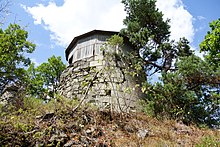Sergei from Glasenapp
Sergey Glazenap , Russia Sergei Pavlovich Glasenapp called ( Russian Сергей Павлович Глазенап * 13 . Jul / 25. September 1848 greg. In Alfimenje at vyshny volochyok , Tver province ; † 12. April 1937 in Leningrad ) was Full Professor of Astronomy at the University of Saint Petersburg , Director of the University Observatory there and Imperial Russian Real State Councilor .
He was one of the founders and long-time chairman of the Russian Astronomers Association and an honorary member of the Imperial Russian, later Soviet Academy of Sciences .
family
Sergei von Glasenapp came from the Pomeranian noble family Glasenapp .
He married Tatiana Vasilyeva in St. Petersburg in 1886 (born January 1, 1864 on the Aral Sea ; † after 1937), from Russian nobility , daughter of the imperial Russian military doctor and real councilor of State Sachar Wassiljew and the adopted daughter of Olga Nikolayevna Butakow, née Besobrasow.
Life
Glasenapp studied at St. Petersburg University until 1870; study visits from 1870 to 1878 in Pulkowo and Germany followed. From 1877 he worked at the University of St. Petersburg, from 1885 to 1924 as a professor.
In 1881, on Glasenapp's initiative and under his direction, the St. Petersburg University Observatory was built.
In May 1892 Glasenapp was from Georgi Alexandrowitsch Romanow , son of Tsar Alexander III. invited to Abastumani (Georgia), who was there to heal a tuberculosis. The tsar's son, who had been interested in astronomy from an early age, asked Glasenapp to find a suitable place to observe the stars, where George Alexandrowitsch had the first astronomical mountain observatory of the Russian Empire built on Mount Kanobili at an altitude of about 1,600 m , first called Georgi and later Glasenapp Tower.
Glasenapp researched a. a. the motion of Jupiter's moons , the orbits of binary and variable stars, and the refraction of light in the earth's atmosphere . In later years he dealt with geodetic methods for the development of oil wells.
honors and awards
In 1920 he was made an honorary member of the Soviet Academy of Sciences, in 1930 he received the Hero of Labor award . He was honored by the Paris Academy of Sciences for his work on double stars .
The moon crater Glazenap and the asteroid (857) Glasenappia were named after him in 1970 .
literature
- Genealogical manual of the nobility , Adelige Häuser A, volume XXI, page 165, volume 98 of the complete series, CA Starke Verlag, Limburg (Lahn) 1990.
Web links
- Publications by S. Glasenapp in the Astrophysics Data System
- B. Fessenkoff: notification of the death of SP Glasenapp. Astronomische Nachrichten, Vol. 264 (1937), p. 115. (Obituary, English)
- Glasenapp Tower
| personal data | |
|---|---|
| SURNAME | Glasenapp, Sergei von |
| ALTERNATIVE NAMES | Glasenapp, Sergei Pawlowitsch; Глазенап, Сергей Павлович (Russian) |
| BRIEF DESCRIPTION | Russian and Soviet astronomer |
| DATE OF BIRTH | September 25, 1848 |
| PLACE OF BIRTH | Alfimenje near Vyshny Volochok , Tver Governorate |
| DATE OF DEATH | April 12, 1937 |
| Place of death | Leningrad , Soviet Union |


